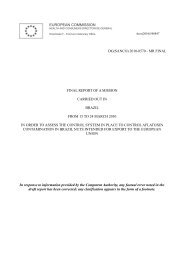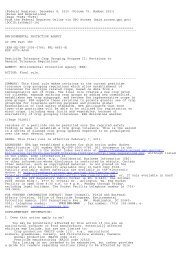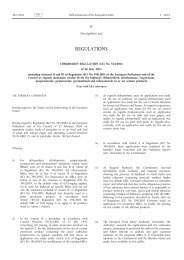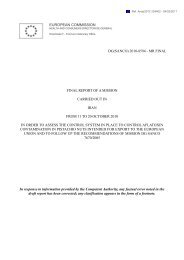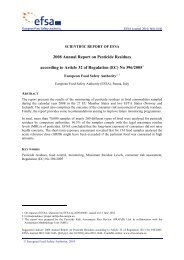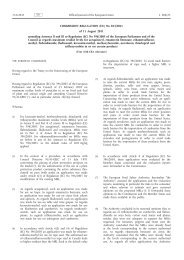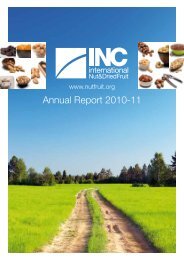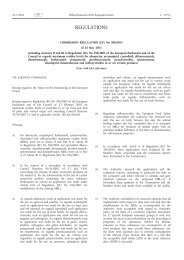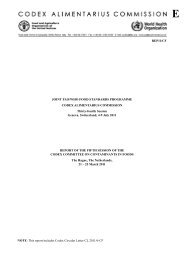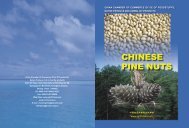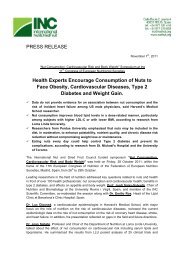REP11/PR JOINT FAO/WHO FOOD STANDARDS PROGRAMME ...
REP11/PR JOINT FAO/WHO FOOD STANDARDS PROGRAMME ...
REP11/PR JOINT FAO/WHO FOOD STANDARDS PROGRAMME ...
You also want an ePaper? Increase the reach of your titles
YUMPU automatically turns print PDFs into web optimized ePapers that Google loves.
<strong>REP11</strong>/<strong>PR</strong> Appendix IX 91<br />
APPENDIX IX<br />
DRAFT <strong>PR</strong>INCIPLES AND GUIDANCE ON THE SELECTION OF RE<strong>PR</strong>ESENTATIVE COMMODITIES<br />
FOR THE EXTRAPOLATION OF MRLS TO COMMODITY GROUPS<br />
(At Step 7)<br />
INTRODUCTION<br />
Residue extrapolation is the process by which the residue levels on representative commodities are utilized to estimate residue<br />
levels on related commodities in the same commodity group or subgroup for which trials have not been conducted. Representative<br />
commodities are chosen based on their commercial importance and the similarity of their morphology and residue characteristics to<br />
other related commodities in the group or subgroup. Ideally representative commodities are the most economically important<br />
commodities in production and/or consumption in a group or subgroup and have a greater dietary burden and have residue<br />
characteristics similar to other members of the group or subgroup. Residue extrapolation is a common consideration utilised by<br />
regulators internationally for ensuring that data requirements are only at a level that is scientifically justified in conducting risk<br />
assessment and to ensure the regulatory process does not become unnecessarily burdensome especially for minor crops.<br />
The objective of this document is to (1) propose criteria for the selection of representative commodities; (2) propose example<br />
representative commodities and (3) provide a detailed justification for the selection of the representative commodities.<br />
GENERAL <strong>PR</strong>INCIPLES<br />
Representative commodities within each Codex Classification commodity group and subgroup will be selected and proposed, based<br />
on consideration of all available information. The following principles will be used for the selection of representative commodities:<br />
• A representative commodity is most likely to contain the highest residues.<br />
• A representative commodity is likely to be major in terms of production and/or consumption.<br />
• A representative commodity is most likely similar in morphology, growth habit, pest problems and edible portion to the related<br />
commodities within a group or subgroup.<br />
The application of the three principles in the selection of representative commodities is based on the assumption that all of the<br />
commodities, covered by the commodity group MRL, are produced following a similar1 use pattern or GAP.<br />
To facilitate the global use of the commodity groups for MRLs, alternative representative commodities may be selected giving<br />
flexibility for use of residue research conducted in different countries or regions that may vary due to regional differences in dietary<br />
consumption and/or areas of production for certain commodities.<br />
Note: Table 1 in this document is provided to (1) separate the selection of representative commodities from the Codex<br />
Classification itself; (2) propose examples of representative commodities in parallel with the respective Codex commodity<br />
grouping classification revisions; (3) provide flexibility on the selection of representative crops and (4) provide guidance not<br />
only to CC<strong>PR</strong> and CC<strong>PR</strong> members, but also to JM<strong>PR</strong>, product manufacturers and other data generators.<br />
Detailed background information regarding production, consumption, MRLs and characteristics and justification for selection of the<br />
representative commodities according to the indicated principles were provided in working documents considered by the Committee<br />
when developing the representative commodities for each commodity group.<br />
GUIDANCE AND <strong>PR</strong>OCEDURES<br />
As proposals for the revision of the Codex Classification are made and revised commodity groupings are developed and provided to<br />
the CC<strong>PR</strong> for their review, proposals on representative commodities will also be provided in parallel with the respective commodity<br />
grouping revisions and will advance through the CC<strong>PR</strong> step process for adoption by the CAC.<br />
As comments are addressed on the revisions of the classification and the proposed representative commodities and these are<br />
approved by the CC<strong>PR</strong> and accepted by the CAC, two separate documents will be created and maintained: (1) the revised Codex<br />
Classification (without mention of representative commodities) and (2) principles and guidance on the selection of representative<br />
commodities.<br />
The JM<strong>PR</strong> may be advised to use the representative commodities adopted by the CAC. However, JM<strong>PR</strong> may use other<br />
representative commodities (including those which may be specifically requested by member nations) on a case-by-case basis. The<br />
JM<strong>PR</strong> will be requested to provide to the CC<strong>PR</strong> justification for the use of any alternative representative commodities, based on all<br />
available data.<br />
1 Submission and Evaluation of Pesticide Residues Data for the Estimation of Maximum Residue Levels in Food and Feed (Section 6.7,<br />
Point a), <strong>FAO</strong> Plant Production and Protection Paper 197, Food and Agriculture Organization of the United Nations, Rome, 2009 (Second<br />
Edition).



